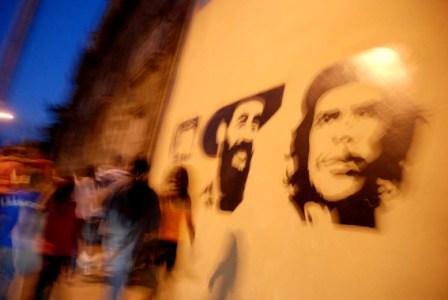Saint Che in the Heavens
Regina Cano

Here, where I struggle to survive every day, I’ve never been short of an idol to admire; one whose collectively received legacy imposes goals and/or conflicts on everyone.
The eminent persons and martyrs in our history were passionate types, full of dreams, possessing great charisma, altruistic individuals with personalities that adoration has polished and converted into immaculate beings, especially those whose “heroism” was proven during the revolutionary deeds of 1959 and after.
These heroes/humans are present daily in the names of schools, polyclinics, Committees for the Defense of the Revolution (CDR), hospitals and neighborhoods. Every new institution is ready to take on the name of a deceased fighter who gave their life in the struggle for our dreams.
This was how the life of “Che” was introduced into the lives of Cubans. He was the Argentinean who dreamed of peace and equality, and who disappeared before demonstrating the opposite.
Ernesto “Che” Guevara de la Serna, “the heroic guerilla fighter,” “the star that lit up the continent”: these are phrases that categorize and accompanied him, and they continue to accompany millions of Cubans all their life.
One day I discovered that his photo —today almost a slogan— “defined the Cuban Revolution.” In addition, he is embodied day after day in the greeting of the Young Pioneers, in pictures and on banners. He has a space on sweaters, as well as in ashtrays for putting out cigarettes; his face is on plates for hanging on the walls of tourists who visit the country.
Concerning pioneers, I can tell about what happened to a mother who accompanied her seven-year-old son to school. She found out that her son didn’t greet the flag, which is accompanied by the incantation “We will be like Che.” Consequently, he was made an example for the others. To this, he (Byron) responded: “But mom, I don’t want to be like Che; I want to be like me, Byron.” He exhibited unwonted independence and definition at such an early age.
Returning to the issue… In unison (which I believe is more like assuming a rearguard position), artisans at craft fairs followed the example with portraits, necklaces and other knickknacks that reminded us of Che.
Despite the indignation of some, this fact ended up becoming normal for citizens so immersed in the crisis period of the ‘90s.
As a result of having spoken of Che with untruths and emptiness, he has been made a symbol for the great majority of adolescent Cubans. So now they wear his picture as a fashion statement, so as not to be outside the group, not for Guevarian ideals.
A young Italian anthropology student in Cuba pointed out that Berlusconi bought the rights to use and market Che’s image in Italy years ago. If that’s true, beyond this ridiculousness of Berlusconi (and that Cuba is not the sole place where the iridescence of a preferred “hero” is sold), it has left me thinking: “Poor Che. What have they done to you man?”






This is what comes of a threadbare revolution allowing — even against the will of its leadership and rank-and-file — the debasement of living, evolving substance into mere dead and ritualistic form. Which thus becomes ripe for exploitation — especially of the capitalist kind. Che Guevara’s legacy may indeed now have the ikonic potential of a Jesus Christ these days — but unlike Jesus, even a dead Che speaks to us beyond the grave: in his writings, in his speeches, and in other accurate means of understanding his intent.
Sure, Che Guevara died too young to disappoint us much in life — but then, if he had *succeeded* in his worthy and (rather too) ambitious goals, Socialism — of whatever form — would today be in a far, far different place than it is, no..?
As for Berlusconi: if what you write of is true, *breaking* such an obscene monopoly should be a priority goal of italian socialist revolutionaries.
It is sad how great, revolutionary thinkers become reduced to a petty fashion that is more marketing than substance. It is like that here in America, where profit-based companies use the image of Che to sell shirts. It’s a little like when Christians mindlessly abuse images of Christ. It isn’t that either lacked substance, it’s that those who use their images use them in a way that alienates both from their substance.
The legendary heros like Che is not only to be remembered as one who could throughout his life sincerly strived to unite the people for the best interest of the toiling masses who are being continiously subejected to inhuman exploitation perpetrated by the desings of imperialism & capitalism, every good human being should also scrupulously follow his path. It is futile to imagine that any one can become Che but , everyone can strive to unite with others on the basis of class identification & march relentlessly to accomplish the tasks as bestowed upon us by the great legacy of Che.